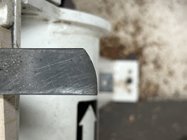I assume square nose scrapers are used to make bottoms flat or cut a square interface with the sides of a piece. However, given the shape it seems as if there is a high likelihood that it would catch easily.
1. What are the uses for a square nose scraper?
2. Are square nose scrapers prone to catches?
3. Will turning them into a NR scraper prevent catches?
1. What are the uses for a square nose scraper?
2. Are square nose scrapers prone to catches?
3. Will turning them into a NR scraper prevent catches?

